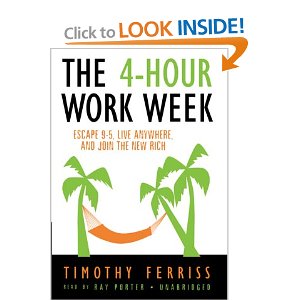
Motivational Book -The 4-Hour Work Week: Escape 9-5, Live Anywhere, and Join the New Rich by Timothy Ferriss
Motivational Book -The 4-Hour Work Week: Escape 9-5, Live Anywhere, and Join the New Rich by Timothy Ferriss
It’s an anomaly for me to even pick a business book up off of the bookstore shelf, much less read it and write about it. Perhaps it was the tempting promise printed so brashly across the gold and white cover of Timothy Ferris’s The 4-Hour Workweek: “Escape 9-5, Live Anywhere, and Join The New Rich.” I’m not alone in taking this bait either as The 4-Hour Workweek has recently spent a number of weeks at the top of the Wall Street Journal’s bestseller list. So what is it that makes Timothy Ferriss’s book better than so many others claiming to deliver a panacea to the tedium endured daily by American cubicle dwellers?
Ferriss states that he himself abandoned the “deferred-life plan” (slave/save/retire) five years ago and has been living the life of the “New Rich.” He regales us early and often with his globe-trotting adventures – kick-boxing in China, tango competitions in Argentina – and he tells us the same is out there for us all if we just follow his simple four point plan.
In Definition, Ferriss explains the concept of lifestyle design while making a convincing argument that we need to rethink our goals. Early on he states that wanting more is misguided, that “most material wants are justifications for spending time on things that don’t really matter, including buying things and preparing to buy things.” He emphasizes that retirement is also a flawed goal, and that the first step in freeing ourselves from the slave/save/retire grind is in defining what our true goals, our dreams, are, a process Ferriss calls “dreamlining.”
Elimination
In the Elimination part of his plan, Ferriss shows us how we can increase our per-hour effectiveness at work by eliminating all that is non-productive and time-wasting from our workdays. He exhorts us to eschew the illusion of the 9-5 workday – we can get the work done in far less time and use the remaining time to our advantage. How? By cultivating selective ignorance and refusing to be jostled from the task at hand by annoy interruptions like phone calls and email. Using his methods, Ferriss claims we can do in two hours what we typically accomplish in eight.
Creating passive income is a key aspect of Ferriss’s plan, and in Automation he lays out a formula for doing just that. There are millions of ways to make millions of dollars, he tells us, but his plan is not for people who want to run businesses but for people who want to own businesses that run themselves. Because only by creating low maintenance revenue streams can we free ourselves to race motorcycles in Mongolia, go heli-skiing out of Helsinki, or whatever it is we’ve chosen as our dreamlines.
Liberation
In Liberation, Ferriss schools employees on “the disappearing act.” What good is freeing up time at the office, if you’re still actually at the office, rather than out building passive revenue streams or pursuing your dreamlines? In this chapter Ferriss explains the art of “mini-retirements” before spending a number of pages on the possibilities and pitfalls for you once you join the “New Rich,” a section which I think most readers will find utterly superfluous.
